Thursday, March 8, 2012
Objects With Stories | Song Dong: Waste Not | Barbican Art Gallery | London
Text Claire Hazelton
Laid out in a sea of colour of gridded artefacts, ordered debris, dust, rust, and taped-up fragments of household objects, Song Dong’s current installation, Waste Not, at the Barbican Curve Gallery, stands as the culmination of the hoardings of the artist’s mother, Zhao Xiangyuan.
The project’s conception stretches back to the sudden death of Song Dong’s father which drove Xiangyuan into a relentless state of depression and grief; this mourning and sense of immense loss, combined with a childhood set against the backdrop of a cultural revolution, political and social turmoil and natural disasters, Song Dong’s mother began to take the Chinese philosophy of "Wu Jin Qi Yong" (Waste Not), to an impressive extreme. However, "Wu Jin Qi Yong" was not only a way of life specific to Song Dong’s mother; it was a common survival tactic for a whole generation of Chinese, a generation bound by a fear of shortage.
Originally Waste Not was created as a collaboration between Song Dong and his mother, but for this current exhibit, following the death of Xiangyuan in 2009, the installation has had to be remade with the help of Song Dong’s wife and sister. The meaning and significance of the installation has been somewhat forced, by tragedy, into transformation; beginning as a representation of a process of Xiangyuan’s grief, it has now become a process of grief in itself.
On entering the space, the viewer is faced with a sign warning about the "fragile" nature of the exhibit. Similarly, parents hold their children back, away from disturbing the colossal collection of ordered bottle caps, polystyrene packaging and shoeboxes. What one might normally value lowly, as waste, rubbish or debris, here is treated with care and sensitivity, like artefacts of value and importance. Like memories, they are precious and stored for the future. Waste Not is a space where a bar of soap and a collection of tiny umbrellas can be viewed as part of a narrative. Wandering through the meticulously folded plastic shopping bags, the towers of empty cardboard boxes and tubes of used toothpaste, the viewer slowly discovers the artist’s life, home and family. A quiet autobiography of Song Dong’s mother begins to unravel amongst the 10,000 or more of her hoarded objects whilst, at the same time, the viewer is exposed to a portrait a China at a time of extreme unrest.
Despite the immensely sensitive and open way Waste Not illuminates the concepts of family, grief and memory, such sensitivity under the clinical lighting of the Curve space seems to become lost. Each object looses a little of its attachment to the human life it was once part of and, somehow, Xiangyuan’s collection of objects becomes relentlessly listing and bleak. Perhaps though this is what Song Dong intends – to highlight the mechanical and seemingly automatic saving of things, the painful clinging to a disappearing past and the clutching towards an empty, baron, disused history. Something bitter pungently hangs in the air here – a failure, perhaps, in the preservation of fading memories; a failure that Xiangyuan was possibly aware of – the pointlessness and absurdity of saving everything, from buckets with holes in to broken chair legs; When Waste Not was first produced as an artwork, she exclaimed to her son "keeping those things was useful wasn’t it!" seemingly aware that her collection would not be useful for anything else.
In a way, the exhibiting of Waste Not removes the heavy sense of loss from the artist’s family, positioning it in a public realm where such grief and obsession can be dissolved, accepted and left behind. Xiangyuan can be imagined saying to the viewer "I collected all of this just for you", handing over all her strangely valueless objects and, in doing so, un-cluttering her house, her life and memories.
Song Dong: Waste Not, 15/02/2012 - 12/06/2012, The Curve Gallery, Barbican Centre, Silk Street, London, EC2Y 8DS. www.barbican.org.uk
Aesthetica in Print
If you only read Aesthetica online, you're missing out. The February/March issue of Aesthetica is out now and offers a diverse range of features from an examination of the diversity and complexity of art produced during the tumultuous decade of the 1980s in Art, Love & Politics in the 1980s, opening 11 February at MCA Chiacgo, a photographic presentation of the Irish Museum of Modern Art's latest opening, Conversations: Photography from the Bank of America Collection. Plus, we recount the story of British design in relation to a comprehensive exhibition opening this spring at the V&A.
If you would like to buy this issue, you can search for your nearest stockist here. Better yet call +44 (0) 1904 629 137 or visit the website to subscribe to Aesthetica for a year and save 20% on the printed magazine.
Photograph by: Jane Hobson
Courtesy Barbican Art Gallery



